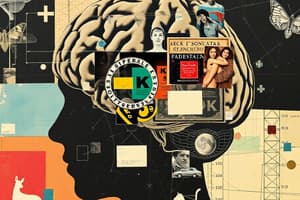Podcast
Questions and Answers
What marks the onset of puberty in females?
What marks the onset of puberty in females?
- Growth spurt
- Menarche (correct)
- Spermarche
- Hormonal changes
Which cognitive development stage is characterized by the ability to engage in hypothetical-deductive reasoning?
Which cognitive development stage is characterized by the ability to engage in hypothetical-deductive reasoning?
- Sensory motor stage
- Preoperational stage
- Formal operational stage (correct)
- Concrete operational stage
Which identity status is characterized by low exploration and high commitment?
Which identity status is characterized by low exploration and high commitment?
- Identity diffusion
- Identity moratorium
- Identity achievement
- Identity foreclosure (correct)
What is a common factor that might contribute to adolescent dropping out of school?
What is a common factor that might contribute to adolescent dropping out of school?
What term describes the phenomenon where adolescents believe that others are as preoccupied with their behavior as they are?
What term describes the phenomenon where adolescents believe that others are as preoccupied with their behavior as they are?
Which stage of moral development involves following rules for the sake of social order?
Which stage of moral development involves following rules for the sake of social order?
Which concept describes the decline of cognitive function associated with aging?
Which concept describes the decline of cognitive function associated with aging?
What is the main benefit of having a strong peer relationship during adolescence?
What is the main benefit of having a strong peer relationship during adolescence?
What is the primary focus of Erikson’s stage of intimacy vs isolation?
What is the primary focus of Erikson’s stage of intimacy vs isolation?
What distinguishes crystallized intelligence from fluid intelligence?
What distinguishes crystallized intelligence from fluid intelligence?
What is a characteristic of the 'sandwich generation'?
What is a characteristic of the 'sandwich generation'?
Which factor is associated with a midlife crisis according to Levinson’s theory?
Which factor is associated with a midlife crisis according to Levinson’s theory?
What does the 'social clock' refer to in the context of early adulthood?
What does the 'social clock' refer to in the context of early adulthood?
What is a significant outcome of successful resolution of Erikson's generativity vs stagnation stage?
What is a significant outcome of successful resolution of Erikson's generativity vs stagnation stage?
What are possible selves in the context of self-concept during middle adulthood?
What are possible selves in the context of self-concept during middle adulthood?
Which of the following is a common physical change associated with middle adulthood?
Which of the following is a common physical change associated with middle adulthood?
Flashcards
Adolescent Puberty
Adolescent Puberty
The period of physical changes that leads to sexual maturity in adolescence, including hormonal changes, growth spurts, and sexual characteristics development.
Primary Sexual Characteristics
Primary Sexual Characteristics
The body structures directly involved in reproduction, like the vagina, penis, and testes.
Secondary Sexual Characteristics
Secondary Sexual Characteristics
Physical traits that develop during puberty that are not directly related to reproduction, like breast development in females and deeper voices in males.
Menarche
Menarche
Signup and view all the flashcards
Spermarche
Spermarche
Signup and view all the flashcards
Formal Operational Stage
Formal Operational Stage
Signup and view all the flashcards
Hypothetical-deductive reasoning
Hypothetical-deductive reasoning
Signup and view all the flashcards
Identity vs. Role Confusion
Identity vs. Role Confusion
Signup and view all the flashcards
Identity Achievement
Identity Achievement
Signup and view all the flashcards
Identity Moratorium
Identity Moratorium
Signup and view all the flashcards
Identity Foreclosure
Identity Foreclosure
Signup and view all the flashcards
Identity Diffusion
Identity Diffusion
Signup and view all the flashcards
Emerging Adulthood
Emerging Adulthood
Signup and view all the flashcards
Identity Development (Emerging Adulthood)
Identity Development (Emerging Adulthood)
Signup and view all the flashcards
Erikson's Intimacy vs. Isolation
Erikson's Intimacy vs. Isolation
Signup and view all the flashcards
Levinson's Seasons of Life
Levinson's Seasons of Life
Signup and view all the flashcards
Social Clock
Social Clock
Signup and view all the flashcards
Attachment Patterns (Childhood)
Attachment Patterns (Childhood)
Signup and view all the flashcards
Sternberg's Triangular Theory of Love
Sternberg's Triangular Theory of Love
Signup and view all the flashcards
Crystallized Intelligence
Crystallized Intelligence
Signup and view all the flashcards
Fluid Intelligence
Fluid Intelligence
Signup and view all the flashcards
Presbyopia
Presbyopia
Signup and view all the flashcards
Generativity vs. Stagnation
Generativity vs. Stagnation
Signup and view all the flashcards
Midlife Crisis
Midlife Crisis
Signup and view all the flashcards
Possible Selves
Possible Selves
Signup and view all the flashcards
Big Five Personality Traits
Big Five Personality Traits
Signup and view all the flashcards
Feminization of Poverty
Feminization of Poverty
Signup and view all the flashcards
Kinkeeper
Kinkeeper
Signup and view all the flashcards
Study Notes
Chapter 11: Physical and Cognitive Development in Adolescence
- Adolescence encompasses hormonal changes, growth spurts, motor development, and sexual maturation (primary and secondary characteristics).
- A secular trend exists in physical development.
- Adolescent brain development is a key area of focus.
- Eating disorders, STIs, adolescent pregnancy, and parenthood are significant considerations.
- Piaget's formal operational stage involves hypothetical-deductive reasoning and propositional thought.
- Adolescent egocentrism, including imaginary audience and personal fable, is a consequence of formal operational thought.
- Information-processing and scientific reasoning are relevant cognitive aspects in adolescence.
- Factors related to school dropout and strategies for prevention are important considerations.
Chapter 12: Emotional and Social Development in Adolescence
- Erikson's identity vs. role confusion stage is central.
- Identity development involves exploration and commitment (identity achievement, moratorium, foreclosure, and diffusion).
- Changes in self-concept and self-esteem are part of adolescent development.
- Kohlberg's stages of moral development (preconventional, conventional, and postconventional) are significant.
- Parent-adolescent relationships influence moral development and other aspects.
- Peer relationships (cliques, crowds) are crucial to social development.
- Effects of social media on well-being (adolescent depression, suicide, delinquency) are important.
Chapter 13: Physical and Cognitive Development in Early Adulthood
- Biological aging (telomeres) and health and fitness (overweight/obesity, benefits of exercise, basal metabolic rate (BMR)) are key.
- Reproductive capacity and substance abuse are considered.
- Changes in cognitive structure and thought (prefrontal cognitive-control network, postformal thought, Perry's epistemic cognition, pragmatic thought, cognitive-affective complexity) are important.
- Expertise and creativity, college experience, and vocational choice are also covered.
Chapter 14: Emotional and Social Development in Early Adulthood
- Emerging adulthood, identity development, successful resolution of intimacy vs. isolation, and Levinson's seasons of life are key topics.
- Close relationships (childhood attachment and adult relationships, Sternberg's triangular theory of love), family life cycle (traditional vs egalitarian marriage, parenthood, cohabitation), and career development are discussed.
Chapter 15: Physical and Cognitive Development in Middle Adulthood
- Physical changes (presbyopia, glaucoma, presbycusis, climacteric/menopause are examined.
- Health and fitness (gender differences, cancer, osteoporosis, hostility, adapting to physical challenges, problem-centered and emotion-centered coping) are important components.
- Mental abilities and information processing (crystalized vs fluid intelligence, working memory, inhibition and flexible shifting of attention) are discussed.
- Adult learners and growth in practical problem-solving are examined.
Chapter 16: Social and Emotional Development in Middle Adulthood
- Erikson's generativity vs. stagnation, Levinson's view, and midlife crisis are covered.
- Midlife is a time of self-concept and personality stability.
- Self-acceptance, autonomy, and environmental mastery are explored.
- Relationships at midlife. Feminization of poverty, kin-keepers, skipped generation families, and sandwich generations are discussed.
- Issues like vocational life and challenges like burnout and the glass ceiling are covered.
Studying That Suits You
Use AI to generate personalized quizzes and flashcards to suit your learning preferences.




